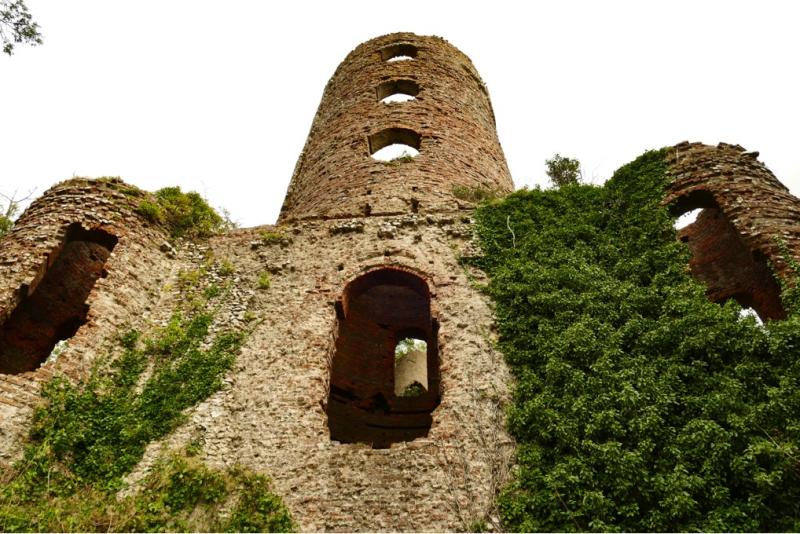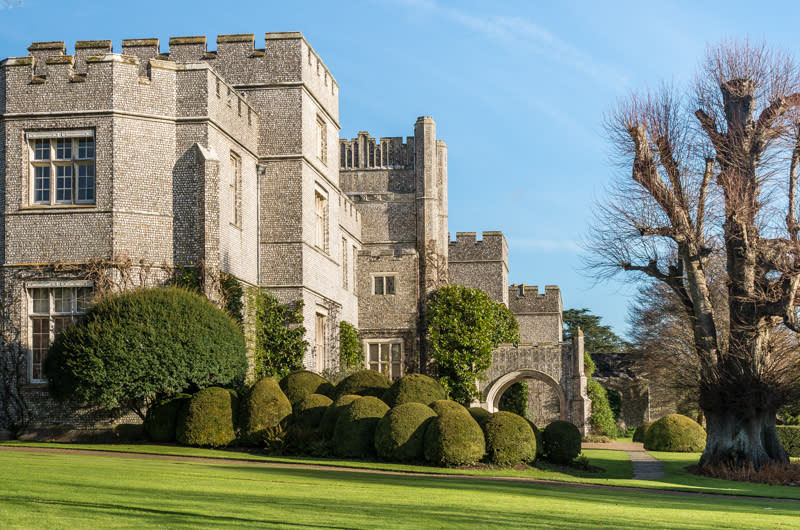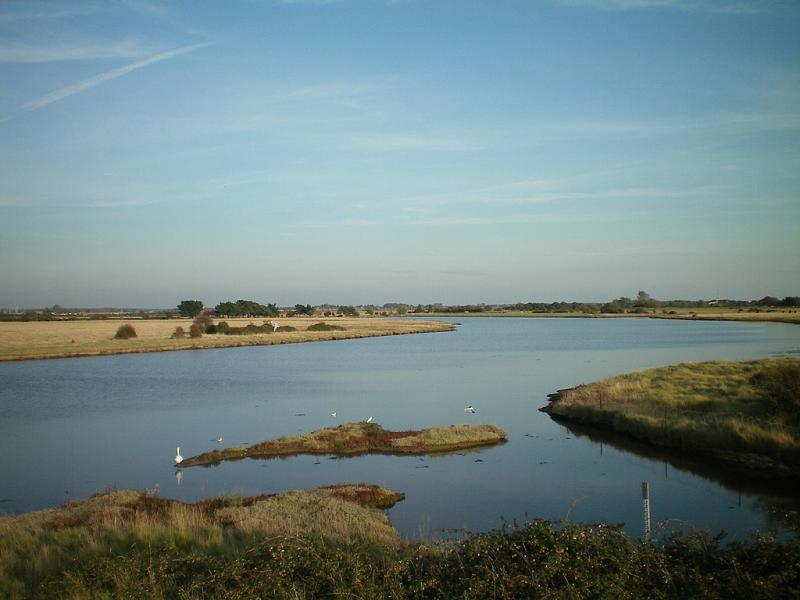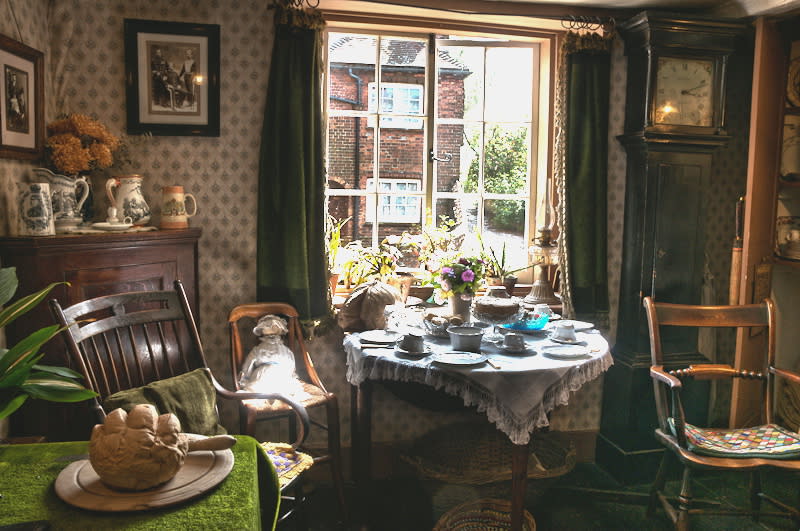Beyond the Tourist Trail: Eight Hidden Gems of West Sussex
From an abandoned school and the most haunted site in Sussex, to an ‘out-of-bounds’ island and a little-known James Bond set right on our doorstep, we’ve uncovered Sussex’s best-kept secrets to bring you the must-visit sites off the tourist trail. But get there soon before the crowds draw in...
See the most Haunted site in Sussex: Racton Monument
Believed to be one of the most haunted sites in Sussex, the Racton Monument has seen everything over the years from paranormal activity to nighttime raves.
While mystery surrounds this unique monument, what’s known is that it was commissioned by Lord Halifax in the mid-18th Century to provide a visual statement on the landscape. It’s believed that the lower floor was used as a banqueting hall, while the upper floors provided the Lord with spectacular views across the South Downs.
The building was partially demolished in the 1780’s and since then, a surge of spooky sightings have been reported, from flying bricks, faces at windows and a ghostly figure, to a phantom tractor.
To add fuel to the fire, a 4,000-year-old skeleton known as the Racton Man was discovered nearby in 1989. Now on display at The Novium Museum, the skeleton is believed to be that of a warrior chief who was killed in battle - he was found lying with his hands clasping a dagger in front of his face. The dagger is the oldest bronze object ever found in Britain and one of the oldest in Europe.
See it for yourself: Follow this three-mile, circular Racton Folly walk by The Ambling Path beginning and ending at Stansted Park.
While you’re here: Stop for a quick refuel at The Fox & Hounds in nearby Funtington. The head into Chichester to pay a visit to The Racton Man at The Novium Museum to learn more about him and his discovery. While you’re there, pop across the road to Chichester Cathedral to learn more about the City’s fascinating history.

Image: The Ambling Path
Discover a House Frequented by Royalty: West Dean House
Set in 6,400 acres of countryside is a 19th Century flint mansion featuring a fascinating artistic heritage, magnificent State Rooms, sprawling landscaped gardens and a 49-acre arboretum.
This flint mansion is, of course, the impressive West Dean House; now home to West Dean College.
Though West Dean is mentioned in the Domesday book as a hunting ground, the first significant house was built here in the 1620s. To give it a more opulent appearance, a suite of grand rooms, tall tower and gardens were added in the early 19th century. The lavish State Rooms - which were designed by prestigious furnishing and decorating specialists, Charles Mellier & Co, to encapsulate the grandeur and opulence of an Edwardian country house - can still be admired today.
While nowadays it’s mostly students you’ll find stepping over its impressive threshold, many key figures in society have been regular visitors to West Dean over the years, including King Edward VII.
See it for yourself: Fancy a weekend in this fascinating flint mansion? You can do just that by signing up to a short course at West Dean College. Choose from a range of traditional subjects including basketmaking, drawing, gardening and mosaics. You can even stay overnight in the house if you’re undertaking a course that’s longer than one day.
While you’re here: Explore West Dean Gardens, or pop to the Weald & Downland Living Museum, just five minutes from West Dean, or head into the City of Chichester for Pallant House Gallery, Chichester Festival Theatre and a huge range of restaurants and cafes.

West Dean College by Ian Capper, CC BY-SA 2.0 Wikimedia Commons
Step on an ‘Out-of-Bounds’ Island: Thorney Island
Found within Chichester Harbour, a National Landscape (formerly Area of Outstanding Natural Beauty /AONB) is Thorney Island.
While Thorney Island is well-known for being an army base, what’s not so well-known (and contrary to popular belief) is that parts of it are accessible to the public. Including its incredible beaches. Walk the outskirts of Thorney Island and not only will you be treated to solitude and far-reaching views, but you’ll also get to see some great wildlife too.
Admire untouched stone and white sand beaches, expansive mudflats, see the 11th Century Church of St Nicholas and its neighbouring war graves and admire the seal and bird colonies at the harbour too. This hidden gem of an island is waiting to be explored.
See it for yourself: Take on the nine-mile loop around Thorney Island, beginning and ending in Emsworth. You will have to pass through gates over the paths on both the east and west sides of the island, but access is allowed. Please be aware there aren't any shops once on the island, so go prepared. Download map here. We recommend checking the tides before you walk as particularly high or spring tides may obstruct parts of the path.
While you’re here: Once you’ve finished your walk, take the 15-minute drive to the harbourside village of Bosham. Well worth the journey, Bosham’s one of the most picturesque villages in West Sussex. Call into Marwick's Brasserie at the Millstream Hotel, or pop to Bosham’s Anchor Bleu for a waterside drink with unbeatable views.

Step Back in Time: Petworth Cottage Museum
While the historic market town of Petworth may have a global following for its arts and antiques, one of its most fascinating museums housing treasures from a time gone by remains vastly undiscovered. Suitably stationed in a prominent position on Petworth’s High Street is the Petworth Cottage Museum, or ‘Mrs Cummings Cottage’ as it’s sometimes known, after Mrs. Mary Cummings, the seamstress at nearby Petworth House who resided here in the early 1900s. The cottage has been restored and furnished as it may have been in 1910, offering a fascinating insight into a time gone by.
Wander through various rooms including a scullery, living room, bedroom, sewing room, attic and cellar, as well as the cottage garden. The museum is also home to a rare collection of Petworth Goss China.
See it for yourself: Petworth Cottage Museum is located at 346 High Street, Petworth. It’s open 2pm to 4.30pm on Tuesday to Saturday, from April until the end of October.
While you're here: Admire the many art and antique stores which dot Petworth's pretty streets, including Petworth Antiques Market, Chequers Antiques, Newlands House Gallery and Kevis House Gallery to name just a few.

Discover a Hidden James Bond set: Amberley Museum
The sleepy village of Amberley may be one of the prettiest villages in Sussex, but did you know it has a rather hefty claim to fame on the big screen? Familiar with A View to a Kill, Roger Moore’s seventh and final outing as 007? While most of the on-screen action took place in the US - pretty apt as the plot centred around America’s Silicon Valley and a threat to San Fransisco - the climax was in fact shot at Amberley Museum.
Back in 1984, the Bond production team set up camp at Amberley to shoot some of A View to Kill’s most crucial scenes. In it, Amberley’s old Chalk Pits and Quarry Tunnel were transformed into the fictional Main Strike Mine where villain Zorin killed the mine workers and schemed to detonate a mine to flood Silicon Valley. Decades on, the original sign from the Bond films is still in place at the museum.
See it for yourself: Admire the set for yourself at Amberley Museum. In the winter season, the museum is open Wednesdays, Saturdays and Sundays and in the summer season Wednesday to Sunday. Please check the website for up-to-date opening times. The Museum often holds a 'James Bond' weekend during the summer - keep your eyes peeled here.
While you’re here: From here it's just a 10-minute drive to Arundel where you can take a tour with Arundel Historic Tours, visit Arundel Castle or enjoy lunch at the Black Rabbit pub.

Follow a Unique Art Trail in the South Downs: Chalk Stones Trail
A five-mile walk fusing art with the beauty of the South Downs, the Chalk Stone Trail is a hidden gem nestled in the heart of the West Sussex countryside. Beginning in the village of Cocking and ending at West Dean, the trail follows 13 Chalk Stone sculptures that have been created by the artist Andy Goldsworthy, famous across the world for his sculptures made from natural materials.
The large chalk stones were excavated from a quarry in West Sussex, chiselled into rounds and then placed - like they would have been in a time gone by to guide travellers - at strategic points along the route. This little-known but fascinating walk follows parts of the famous South Downs Way, and crosses land owned by the West Dean Estate. You’ll take in incredible views, pass a bronze age barrow and see the ruins of one of the old Midhurst to Chichester Railway arches, whilst admiring the chalk stone sculptures and many other delights along the way.
See it for yourself: The trail begins at the bus stop at Cocking Hill and finishes at West Dean College. View the full route here.
While you’re here: Grab breakfast before you get going at The Blue Bell, Cocking’s friendly and welcoming community-run pub. At the end of the trail, before you catch the bus back to Cocking, take a visit to West Dean Gardens making sure you pop into the café there, for a delicious bite to eat. Also close by is West Dean Stores and Tearoom, for sustenance on the go.

Spot the World’s Fastest Animal: Chichester Cathedral
As an Area of Outstanding Natural Beauty (AONB) Chichester Harbour is famous for the rare birdlife that calls it home. But did you know, Chichester’s City Centre is also home to the fastest animal in the world? Peregrine Falcons - best known for their diving speed during flight which can reach more than 186 miles per hour - have been regularly using the spire at Chichester’s historic Cathedral as a nesting ground since 2001, fledging over 70 Peregrine Falcon chicks.
Peregrine Falcons were first spotted on the spire in the mid-1980s. Considering parts of the spire date back to 1400, it’s anyone’s guess how long they’ve really been there. Since 2001 a group of local enthusiasts have been tracking their progress, and you can now watch the Peregrine Falcons building and fledging their nests, and everything in-between, every April through to August via a webcam.
See it for yourself: Why watch online when you can see the Peregrine Falcons with your own eyes? During June and July the Chichester peregrine project often runs drop-in open days on the Cathedral Green where you can view the birds through telescopes (The Peregrine project is a collaboration between Chichester Cathedral, the Sussex Ornithological Society (SOS), Carnyx and local wildlife enthusiasts David and Janet Shaw). It's worth remembering to take your binoculars if you want to observe the birds.
While you’re here: Pop across the road to the Novium Museum, where there’s a viewing platform of the city. With great views across to the Cathedral, you may be in luck of spotting a Peregrine. You’ll find many great lunch spots in the City, including Cloisters Kitchen at the Cathedral, as well as popular spots across the city centre; Bills Restaurant, Reina Kitchen, Purchases Chichester and The Ivy.

Find an Abandoned School: Bedham Church and School Ruins
In an enchanting woodland just outside of the historic market town of Petworth, lay the ruins of an abandoned school and church, if you can find them! One of the area's best kept secret from visitors and locals alike are the ruins of Bedham Church and School, or St Michaels and All Angels Anglian Church as it was once known.
Built in 1880 to serve the hamlet of Bedham, St Michaels and All Angels was built by William Townley Mitford MP to act as a school during the week and a church at weekends. The building was divided by a curtain for different classes. On a Friday afternoon the room was transformed - with chairs turned eastwards and ink pots removed from the desks - ready for the weekend’s church service.
While it’s believed that at its peak the school had 60 students and three teachers, it closed its doors just before the First World War and the church followed suit in 1959 due to dwindling numbers. Today, while just the shell of the building remains, it’s in great condition with many original features still to be admired. The perfect attribute to an enchanting woodland walk.
See it for yourself: Hidden gem is no understatement when it comes to Bedham Church and School Ruins, with many people having struggled to stumble upon them. If you’re up for the challenge, head to The Mens Nature Reserve, a quiet wood off Wakestone Lane and see if you can find them for yourself.
While you’re here: Just 15-minutes by car from the hamlet of Bedham is Upperton Vineyard. Whether you’re celebrating finding the ruins, or commiserating, the award-winning Upperton Vineyard is well worth a visit. Or continue into the market town of Midhurst to visit the award-winning Cowdray Farm Shop and Café.

More West Sussex Gems
Other lesser known attractions to seek out include the tranquility of Chichester Canal, wildlife-packed tours of Chichester Harbour, exploring Selsey's Marine residents with an expert guide and Goodwood's Aerodrome Cafe where your cup of coffee might just be accompanied by Spitfire take-off! Inspired to look for more great things to do in West Sussex? Click here.
